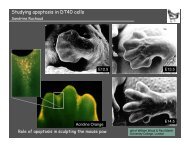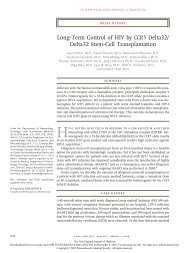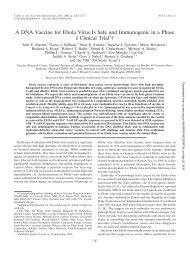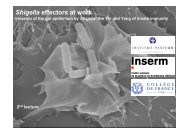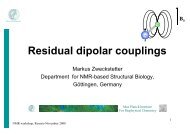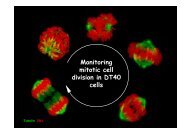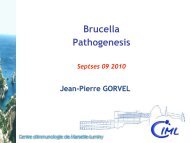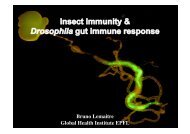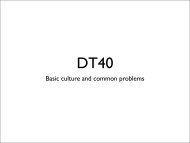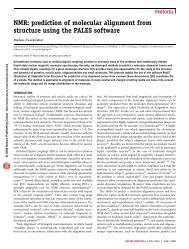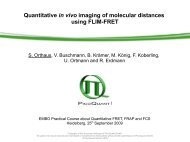pdf file - Events - EMBO
pdf file - Events - EMBO
pdf file - Events - EMBO
Create successful ePaper yourself
Turn your PDF publications into a flip-book with our unique Google optimized e-Paper software.
<strong>EMBO</strong> Plant DNA Repair and Recombination Workshop, Presqu'île de Giens, France 2007<br />
suppresses recombination between divergent direct repeats in somatic cells or between<br />
homologs from different ecotypes during meiosis. We describe the involvement of other<br />
genes from the mismatch repair family on homologous recombination and discuss the<br />
implications of these results for plant improvement via gene transfer across species.<br />
----------------------------------------------------------------------------------------------------------------------------------<br />
P - 11. Transient inactivation of NHEJ proteins<br />
Sylvia de Pater, Vanessa Costa, Paul Hooykaas. Institute Biology Leiden, Leiden University,<br />
2333 AL Leiden, Netherlands<br />
Agrobacterium tumefaciens T-DNA normally integrates into random sites in the plant<br />
genome and frequencies of gene targeting (GT) in plants are very low. It would be an<br />
advantage for analysis of gene function and for exploitation of genetically modified<br />
organisms if the frequency of targeted integration could be increased. Experiments with<br />
yeast mutants have shown that GT can be enhanced by mutations in the DNA repair<br />
pathway of non-homologous end joining (NHEJ)(1). Subsequently, Arabidopsis NHEJ T-<br />
DNA insertion mutants have been tested in GT experiments, and preliminary results show<br />
that GT frequency is improved somewhat in these mutants. Since constitutive inhibition<br />
of the NHEJ DNA repair pathway results in telomere lengthening (2,3) and maybe other<br />
DNA rearrangements, we applied the peptide aptamer technology (4) combined with an<br />
inducible promoter system for the temporary inactivation of NHEJ proteins. A peptide<br />
aptamer has been isolated that binds to AtKu80 and yKu80 in yeast (Y2H) and in vitro<br />
and expression in yeast and Arabidopsis results in more sensitivity for DNA damage<br />
inducing agents. 1. van Attikum H and Hooykaas PJJ (2003) Genetic requirements for<br />
targeted integration of Agrobacterium T-DNA in Saccharomyces cereviciae. Nucl Acid Res<br />
31, 826-832. 2. Bundock P, van Atticum H, Hooykaas P (2002) Increased telomere length<br />
and hypersensitivity to DNA damaging agents in an Arabidopsis KU70 mutants. Nucleic<br />
Acids Res 30, 3395-3400. 3. Bundock P and Hooykaas P (2002) Severe developmental<br />
defects, hypersensitivity to DNA-damaging agents, and lengthened telomeres in<br />
Arabidopsis MRE11 mutants. Plants Cell 14, 2451-2462. 4. Colas P, Cohen B, Jessen T,<br />
Grishina, McCoy J, Brent R (1996) Genetic selection of peptide aptamers that recognize<br />
and inhibit cyclin-dependent kinase 2. Nature 380, 548-550.<br />
----------------------------------------------------------------------------------------------------------------------------------<br />
P - 12. ADI IS A NOVEL COMPONENT OF THE ARABIDOPSIS SOMATIC DNA<br />
DOUBLE STRAND BREAK RESPONSE AND IS ESSENTIAL FOR MEIOSIS<br />
Philip Dean, Susan Armstrong, Christopher West. CENTRE FOR PLANT SCIENCES,<br />
UNIVERSITY OF LEEDS, UK, LS2 9JT Leeds, United Kingdom<br />
Here we describe ATM DEPENDENT INDUCTION (ADI), a plant specific gene which shows a<br />
large induction specifically in response to genotoxic stress. Quantitative PCR<br />
demonstrates that the induction of ADI is dependent on the protein kinase ATM, placing<br />
ADI in an ATM pathway. ADI is also essential for Arabidopsis meiosis as adi knockout<br />
mutant plants are both male and female sterile. Detailed cytological analysis of these<br />
mutants reveals extensive chromosome fragmentation during meiosis. Studies in an adi<br />
heterozygous background correlate with ADI also being required for pollen mitosis as<br />
there is a failure to complete mitotic cell divisions in approximately half the pollen.<br />
Preliminary yeast 2-hybrid interaction studies indicate ADI may interact with components<br />
required for both DNA double strand break repair and cell cycle progression.<br />
----------------------------------------------------------------------------------------------------------------------------------<br />
P - 13. A Cre::FLP fusion protein recombines FRT or loxP sites in transgenic maize<br />
plants<br />
Vesna Djukanovic, Brian Lenderts, Alex Lyznik. Crop Genetics Research, Pioneer Hi-Bred<br />
Page 34 sur 56



